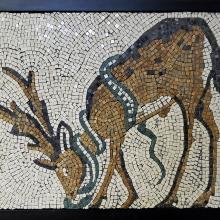This entry is a Deer and Snake mosaic I made in February of 2021
When I was in Istanbul, Turkey in 2013 with my friend, we had the unique opportunity to go to the Great Palace Mosaic Museum.
This amazing mosaic floor was excavated in 1935 and put on display in 1997.
The Palace was created as part of a large complex on a hill. The estimated construction starts dates around Justininan 527. Over the years it was palace was destroyed in 532, renovated around 685, used as a prison in the 14th and 15th centuries until excavation.
This surviving 250 square meter mosaic is an enormous floor of some 75 to 80 million stone, ceramic and glass pieces. Most pieces/tesserae are about 5mm in size. When this mosaic was originally created it used a lime putty mortar as the adhesive and grout.
I chose the deer and snake mosaic which I did see but unfortunately didn’t take a picture of. My source image is from the book I bought from the museum on site. This unique mosaic shows a common life with people, crops and animals of that time.
The Deer and Snake motif in Greek and Roman art depicts the rivalry of the two animals. Apparently, the deer is capable of drawing the snake out of it’s den by using it’s breath and is immune to it’s venom. The deer’s head is lower showing it grabbing the snake by the head.
I had to modify this mosaic to make it lighter weight to put into a picture frame. To do this I didn’t use multiple layers or mortar and instead I used a piece of wedi-board and drew the design directly on it.
The tesserae/tile would have been broken by a hammer and hardie. I do own a hammer and hardie but the repetitive motion and weight were getting to be difficult to use. Instead, my lovely husband bought me a chopping machine that uses a twisting screw to bring the 2 chisel heads down to break the stone. My tesserae would about 8 to 10 mm which is larger than the 5mm that was originally used.
I made the mortar from a thinset found at the hardware store and tinted to look old with concrete dye. The original mortar would have been white lime but over time would have darkened with age and dirt.
In that period, a team of workers would have been laying the mortar, cutting the tesserae, marking the area and pushing in the tesserae into the mortar. Since I don’t have a team, I put the mortar/thinset into a frosting bag and worked on areas of the mosaic in 3 hour chunks.
Since my tesserae were larger than the original some of the finer detail isn’t as clearly achieved.
I worked on the deer 1st and then the background. I’m not sure in period if this was the same order.
When I completed the mosaic, I tacked it into a frame and made it ready to hang.
A final step, that I didn’t have to do, would have been to use a pumic stone to level out the floor and polish the surface of the stone. The stone I used already had a polished surface.
Great Palace Mosaic Museum, Bilkent Kultur Grisimi Publications, Gurol Sozen, Erdem Yucel, August 2010. ISBN 978-605-5495-03-9
Personal Trip to Istanbul, Turkey July 2013

